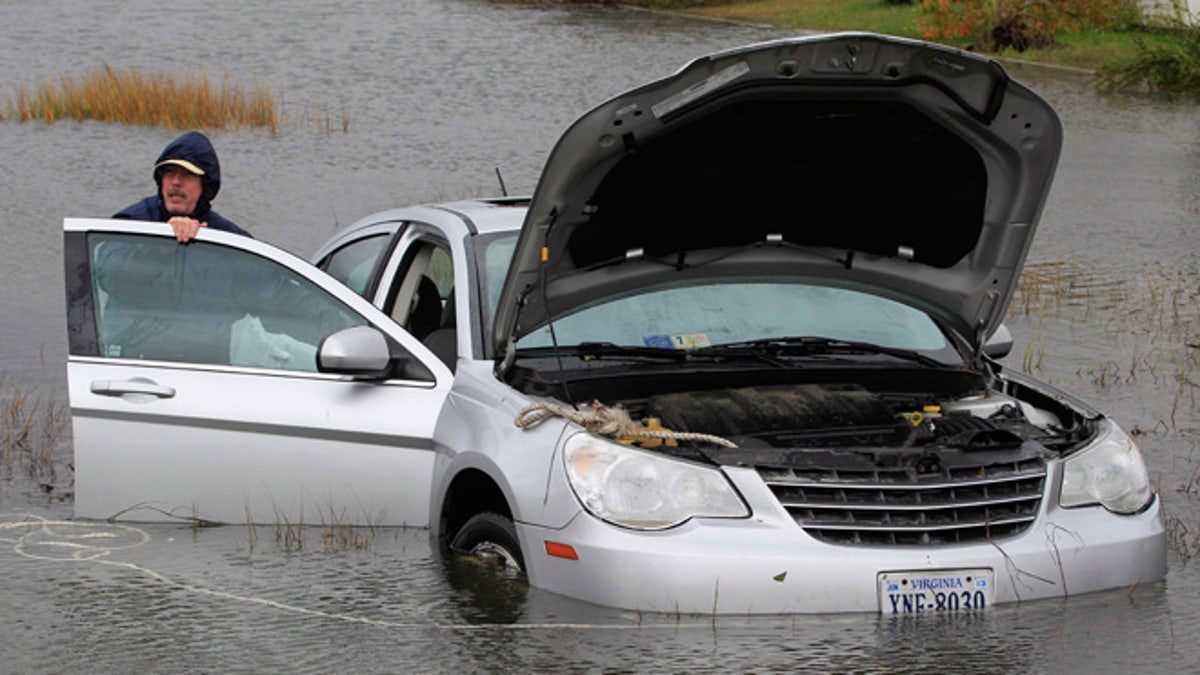
(AP)
If your car or truck was damaged by the effects of superstorm Sandy, there’s some good news: you’re probably covered.
According to Insure.com, comprehensive automobile insurance plans generally include damage caused by natural disasters and about 80 percent of car owners have this type of policy. Unfortunately, if you carry only liability insurance you’re out of luck.
In either case, especially if you're a do-it-yourselfer, you still have to be careful when dealing with the vehicle, especially one that has been subjected to flooding, as everything you do to it could be dangerous or make matters worse.
Tony Molla, Vice President of Communications at the National Institute for
Automotive Service Excellence recommends that you call your insurance company before you do anything to the car and follow any specific procedures they recommend, as to not violate the terms of your coverage. Jon Linkov, Managing Editor for Consumer Reports Cars, suggests that you also take plenty of photos to document any damage or how deep the car was underwater.
After that, you should wait at least 24 hours before you do anything to the vehicle, giving it time to drain, if not completely dry out. If the water got so deep that the dashboard was covered, Molla says you shouldn’t try to start it at all. If any liquid is in the cylinders it will cause hydrolock and bend the connecting rods for the pistons as they try to compress the incompressible fluid, further damaging the engine. Most of the electronics in the car would have been submerged at this depth, as well, and there’s a good chance the insurance company will simply total it.
If you don’t think the water got that high, Molla says it’s still best to take a look at the oil dipstick to see if there are any traces of water in the lubrication system. If so, assume the engine is flooded and don’t try to start it.
You’re in better shape if the water stayed below the center line of your wheels. Nevertheless, Linkov says to let the interior air out as much as possible before trying to start it, taking out the floor mats, trunk mat and even the seats, if you’re so inclined. He adds that much of the wiring and some of the computers in today’s cars are located under the carpet and along the central tunnel, so even if the engine compartment wasn’t inundated, you could still experience faults to secondary systems.
If the vehicle starts, take a good look at all of the dashboard warning lights and try out all of the accessories. For example, Linkov points out that even if the stereo works, the satellite radio often runs off of a separate computer and its brains might be fried, so give everything a good once over.
But even if it all checks out, you may not be out of the woods. Some water could remain trapped in hard to reach places, leading to electronic issues down the road. If any problems appear in the weeks following a flood, they were likely caused by it, so keep an eye out for glitches.
Keep in mind that electronic gremlins aren’t the only thing that can haunt a car that suffered only minor flooding. Molla says water can corrode the insides of drum brake systems or flush the lubricant out of disc brake calipers, both of which can lead to eventual failures. Also, the pressure vent on the front or rear differential can get clogged and cause a seal to burst, allowing the oil to drain out, which can lead to a very expensive repair if it is not addressed in time. It’s best to have these inspected by a professional, especially if your car was sitting in water for any length of time.
When it comes to hybrid and electric cars, Linkov and Molla agree that they need to be handled with special care given their complex, high voltage electrical systems and battery packs. If one of these types of vehicles is subjected to any level of flooding, they advise having it towed to a dealer or a service center as soon as possible.
Finally, as with anything, when in doubt, call a professional.